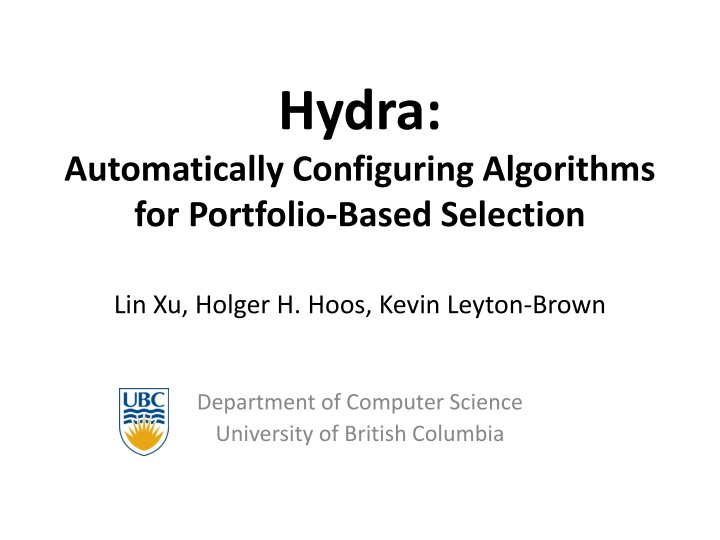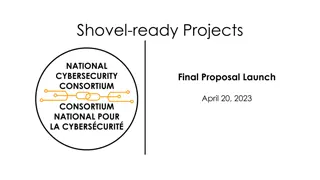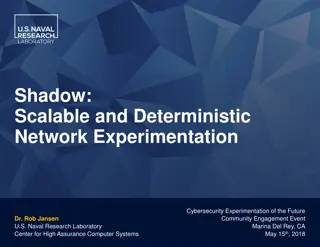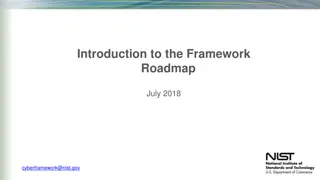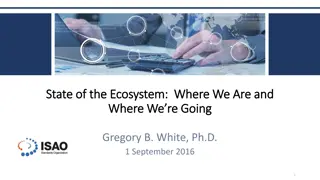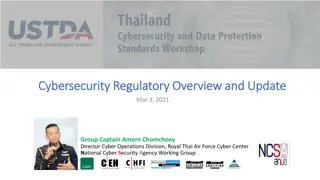Optimal Approach for PSAPs Cybersecurity
Implementing optimal cybersecurity practices for Public Safety Answering Points (PSAPs) is crucial to safeguard against cyber threats. This content discusses the current cyber security landscape, federal roles, best practices, and workforce frameworks related to PSAP cybersecurity. It also outlines the importance of governance, access control, security controls, and network security in PSAP environments. Furthermore, it highlights the work of federal entities like the U.S. Department of Commerce NIST and the Department of Homeland Security in enhancing cybersecurity for critical infrastructure programs.
Download Presentation

Please find below an Image/Link to download the presentation.
The content on the website is provided AS IS for your information and personal use only. It may not be sold, licensed, or shared on other websites without obtaining consent from the author.If you encounter any issues during the download, it is possible that the publisher has removed the file from their server.
You are allowed to download the files provided on this website for personal or commercial use, subject to the condition that they are used lawfully. All files are the property of their respective owners.
The content on the website is provided AS IS for your information and personal use only. It may not be sold, licensed, or shared on other websites without obtaining consent from the author.
E N D
Presentation Transcript
Hydra: Automatically Configuring Algorithms for Portfolio-Based Selection Lin Xu, Holger H. Hoos, Kevin Leyton-Brown Department of Computer Science University of British Columbia
Two automated algorithm design ideas SATzilla SATenstein [KhudaBukhsh, Xu, Hoos, Leyton-Brown, 2009] algorithm design via automatic configuration [Xu, Hutter, Hoos, Leyton-Brown, 2007; 2008] portfolio-based algorithm selection Xu, Hoos, Leyton-Brown. Hydra: Automatically Configuring Algorithms for Portfolio-Based Selection
Two automated algorithm design ideas SATzilla [Xu, Hutter, Hoos, Leyton-Brown, 2007; 2008] portfolio-based algorithm selection Exploit per-instance variation between solvers using learned runtime models practical: e.g., won 10 medals in 2007, 2009 SAT competitions fully automated: requires only cluster time rather than human design effort Key drawback: requires a set of strong, relatively uncorrelated candidate solvers can t be applied in domains for which such solvers do not exist Some particularly related work: [Rice, 1976]; [Leyton-Brown, Nudelman & Shoham, 2003; 2009]; [Guerri & Milano, 2004]; [Nudelman, Leyton-Brown, Shoham & Hoos, 2004] Xu, Hoos, Leyton-Brown. Hydra: Automatically Configuring Algorithms for Portfolio-Based Selection
Two automated algorithm design ideas SATenstein [KhudaBukhsh, Xu, Hoos, Leyton-Brown, 2009] algorithm design via automatic configuration Instead of manually exploring a design space, build a highly-parameterized algorithm and then configure it automatically Can find powerful, novel designs matched or outperformed existing SLS algorithms on six SAT domains But: only produces single algorithms designed to perform well on the entire training set Some particularly related work: [Gratch & Dejong, 1992]; [Fukunaga, 2002]; [Balaprakash, Birattari & Stutzle, 2007]; [Hutter, Babic, Hoos & Hu, 2007]; [Ansotegui, Sellmann & Tierney, 2009]; [Hutter, Hoos, Stutzle & Leyton-Brown, 2009] Xu, Hoos, Leyton-Brown. Hydra: Automatically Configuring Algorithms for Portfolio-Based Selection
Two automated algorithm design ideas Hydra automatic portfolio synthesis Starting from a single parameterized algorithm, automatically find a set of uncorrelated configurations that can be used to build a strong portfolio. Xu, Hoos, Leyton-Brown. Hydra: Automatically Configuring Algorithms for Portfolio-Based Selection
Plan of This Talk Background SATzilla: Portfolio-Based Algorithm Selection SATenstein: Algorithm Configuration as Design Portfolio Synthesis Related Work Hydra Experimental Results Conclusions and Future Work Xu, Hoos, Leyton-Brown. Hydra: Automatically Configuring Algorithms for Portfolio-Based Selection
SATzilla: Portfolio-Based Algorithm Selection [Xu, Hutter, Hoos, Leyton-Brown, 2007; 2008] Given: training set of instances performance metric candidate solvers portfolio builder (incl. instance features) Metric Training Set Candidate Solvers Training: collect performance data portfolio builder learns predictive models Portfolio Builder At Runtime: predict performance select solver Selected Solver Novel Instance Portfolio-Based Algorithm Selector Xu, Hoos, Leyton-Brown. Hydra: Automatically Configuring Algorithms for Portfolio-Based Selection
SATenstein: Automated Algorithm Design [KhudaBukhsh, Xu, Hoos, Leyton-Brown, 2009] Designer creates highly- parameterized algorithm from existing components Existing Algorithm Components Given: training set of instances performance metric parameterized algorithm algorithm configurator Domain Expert Configure algorithm: run configurator on training instances output is a configuration that optimizes metric Parameterized Algorithm Xu, Hoos, Leyton-Brown. Hydra: Automatically Configuring Algorithms for Portfolio-Based Selection
SATenstein: Automated Algorithm Design Designer creates highly- parameterized algorithm from existing components Metric Given: training set of instances performance metric parameterized algorithm algorithm configurator Instance set Algorithm Configurator Configure algorithm: run configurator on training instances output is a configuration that optimizes metric New Parameterized Algorithm Configuration Xu, Hoos, Leyton-Brown. Hydra: Automatically Configuring Algorithms for Portfolio-Based Selection
Plan of This Talk Background SATzilla: Portfolio-Based Algorithm Selection SATenstein: Algorithm Configuration as Design Portfolio Synthesis Related Work Hydra Experimental Results Conclusions and Future Work Xu, Hoos, Leyton-Brown. Hydra: Automatically Configuring Algorithms for Portfolio-Based Selection
Related Work Algorithm synthesis; portfolios and online algorithm selection [Minton 1993]; [Huberman, Lukose & Hogg 1997]; [Howe et al, 1999]; [Gomes & Selman 2001]; [Carchrae & Beck 2005]; [Gagliolo & Schmidhuber 2006]; [Streeter, Golovin & Smith 2007]; [Roberts & Howe, 2007]; [Gaspero & Schaerf 2007]; [Monette, Deville & van Hentenryck 2009] Two proposals for synthesis of selection-based portfolios: 1. Boosting as a Metaphor for Algorithm Design [L-B et al., 2003; 2009] 2. Stochastic Offline Programming[Malitsky & Sellmann, 2009] partition instances into k clusters based on features find best-performing algorithm for each cluster assumes that all algorithms repeatedly (1) sample from a distribution over heuristics; (2) use the sampled heuristic for one search step best-performing algorithms identified using a custom optimization method our goal is to construct an entirely general method for portfolio synthesis CP-Hydra[O Mahony, Hebrard, Holland, Nugent, & O Sullivan, 2008] selection-based portfolio for constraint programming Xu, Hoos, Leyton-Brown. Hydra: Automatically Configuring Algorithms for Portfolio-Based Selection
Boosting as a Metaphor for Algorithm Design [Leyton-Brown, Nudelman, Andrew, McFadden, Shoham, 2003]; [Leyton-Brown, Nudelman, Shoham, 2009] Core idea re-weight instance distribution to emphasize problems on which an existing portfolio P performs poorly Interpretation as an automatic procedure: generate a new distribution D that is hard for P find a new solver maximizing average performance on D We intended to implement this procedure. But: discovered examples in which the algorithm with best average performance does not improve the portfolio thus, the portfolio synthesis procedure can stagnate, even when other, helpful algorithms exist Xu, Hoos, Leyton-Brown. Hydra: Automatically Configuring Algorithms for Portfolio-Based Selection
Hydra: Dynamic Performance Metric Avoid stagnation via a dynamic performance metric: return performance of s when s outperforms P return performance of P otherwise Intuitively:s is scored for its marginal contribution to P This metric is given to an off-the-shelf configurator, which optimizes it to find a new configuration s* Thus, we retain the same core idea as boosting build a new algorithm that explicitly aims to improve upon an existing portfolio Contrast with Stochastic Offline Programming: algorithms target sets of instances having very different features these feature differences can be irrelevant to algorithm performance Xu, Hoos, Leyton-Brown. Hydra: Automatically Configuring Algorithms for Portfolio-Based Selection
Hydra Procedure: Iteration 1 Parameterized Algorithm Metric Candidate Solver Set Training Set Algorithm Configurator Portfolio Builder Candidate Solver Portfolio-Based Algorithm Selector Xu, Hoos, Leyton-Brown. Hydra: Automatically Configuring Algorithms for Portfolio-Based Selection
Hydra Procedure: Iteration 2 Parameterized Algorithm Metric Candidate Solver Set Training Set Algorithm Configurator Portfolio Builder Candidate Solver Portfolio-Based Algorithm Selector Xu, Hoos, Leyton-Brown. Hydra: Automatically Configuring Algorithms for Portfolio-Based Selection
Hydra Procedure: Iteration 3 Parameterized Algorithm Metric Candidate Solver Set Training Set Algorithm Configurator Portfolio Builder Candidate Solver Portfolio-Based Algorithm Selector Xu, Hoos, Leyton-Brown. Hydra: Automatically Configuring Algorithms for Portfolio-Based Selection
Hydra Procedure: After Termination Output: Selected Solver Novel Instance Portfolio-Based Algorithm Selector Xu, Hoos, Leyton-Brown. Hydra: Automatically Configuring Algorithms for Portfolio-Based Selection
Plan of This Talk Background SATzilla: Portfolio-Based Algorithm Selection SATenstein: Algorithm Configuration as Design Portfolio Synthesis Related Work Hydra Experimental Results Conclusions and Future Work Xu, Hoos, Leyton-Brown. Hydra: Automatically Configuring Algorithms for Portfolio-Based Selection
Problem Domain Even though Hydra is most useful in other domains, we evaluated it on SAT. High bar for comparison strong state-of-the-art solvers portfolio-based solvers already successful to be able to argue that Hydra does well, we want to compare to a strong portfolio Pragmatic benefits a wide variety of interesting datasets existing instance features SATenstein is a suitable configuration target Xu, Hoos, Leyton-Brown. Hydra: Automatically Configuring Algorithms for Portfolio-Based Selection
Experimental Setup: Hydras Inputs Portfolio Builder:SATzilla framework [Xu, Hutter, Hoos, Leyton-Brown, 2008] Parameterized Solver:SATenstein-LS [KhudaBukhsh, Xu, Hoos, Leyton-Brown, 2009] Algorithm Configurator:FocusedILS 2.3 [Hutter, Hoos, Leyton-Brown, 2009] Performance Metric:Penalized average runtime (PAR) Instance Sets: 2 from SATenstein paper [KhudaBukhsh, Xu, Hoos, Leyton-Brown, 2009] 2 from previous SAT competitions Xu, Hoos, Leyton-Brown. Hydra: Automatically Configuring Algorithms for Portfolio-Based Selection
Experimental Setup: Challengers Individual state-of-the-art solvers 11 manually-crafted SLS solvers all 7 SLS winners of any SAT competition 2002 2007 4 other prominent solvers 6 SATenstein solvers Also considered portfolios of challengers used same portfolio builder (SATenstein) Xu, Hoos, Leyton-Brown. Hydra: Automatically Configuring Algorithms for Portfolio-Based Selection
Performance Summary Solver RAND HAND BM INDU Best Challenger (of 17) 1128.63 2960.39 224.53 11.89 Portfolio of 11 Challengers 897.37 2670.22 54.04 135.84 Portfolio of 17 Challengers 813.72 2597.71 3.06* 7.74* Hydra (7 iterations) 631.35 2495.06 3.06 7.77 * Statistically insignificant performance difference (sign rank test). Hydra s performance was significantly better in all other pairings. Xu, Hoos, Leyton-Brown. Hydra: Automatically Configuring Algorithms for Portfolio-Based Selection
Performance Progress, RAND Xu, Hoos, Leyton-Brown. Hydra: Automatically Configuring Algorithms for Portfolio-Based Selection
Selection Percentages After 7 Iterations, RAND Xu, Hoos, Leyton-Brown. Hydra: Automatically Configuring Algorithms for Portfolio-Based Selection
Improvement After 7 Iterations, RAND Xu, Hoos, Leyton-Brown. Hydra: Automatically Configuring Algorithms for Portfolio-Based Selection
Conclusions Hydra: an automatic design approach combining portfolio-based algorithm selection(here: SATzilla ) automated algorithm configuration (here: SATenstein ) Completely automated Algorithm/configurator/portfolio-builder agnostic Most useful in domains where few strong solvers exist Nevertheless met or exceeded state-of-the-art performance on SLS for SAT in 4 domains Thank You! Xu, Hoos, Leyton-Brown. Hydra: Automatically Configuring Algorithms for Portfolio-Based Selection
